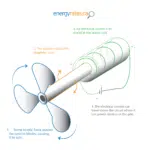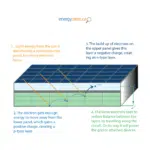You may think nothing of flicking the lights on or plugging in your laptop, but far away from your home are massive facilities dedicated to harvesting that energy to send to your home. So much of our modern lives wouldn’t be possible without thousands of watts travelling on miles of copper wire.
Despite its prevalence, many people don’t know how electricity is generated. It’s a relatively straightforward process, and here we try to simplify it as much as possible so you can get the picture.
A brief history of the generator
Most electrical generators stem from a principle discovered of electromagnetism. Among many other discoveries, in 1831 Michael Faraday discovered a relationship between magnetic fields and electricity in which one could influence the other. He found that rotating a magnet inside a metal coil of wire on a circut would induce an electrical current in the wire.
Energy is neither created nor destroyed but transformed from one state to another. Thus, in Faraday’s discovery, the kinetic energy from rotating the magnet would be transformed into electrical energy within the circuit.
How an electrical generator works
Electromagnetic generators simply transform the kinetic energy derived from its respective source into electrical energy. Fossil fuels, biomass and nuclear energy all use heat to turn water in a boiler into steam. This fast-moving steam is channelled towards a turbine. The turbine then rotates a magnetic core, known as a rotor, inside a series of insulated coils of wire, known as a stator. This induces an electrical current in the power plant that then powers the rest of the grid.

In combined-cycle power plants, natural gas can also be compressed with other gases so that it expands when heated. As it expands it spins a primary set of turbines and then goes on to heat a boiler. This makes the generation more efficient as exhaust heat energy is used to generate additional electricity, rather than escape the system.
Most renewable energy plants are just finding sources of energy that are abundant and already present in nature and won’t be used up in the process. Since waterfalls and wind are already kinetic, you can simply place your turbine in its path to kickstart your generation in a natural process.
How hydroelectricity is generated
Hydroelectricity is Canada’s most consumed and produced source of electricity. Roughly 60% of Canadian electricity is generated from water, with Quebec generating the most of any province and housing the biggest dams in the country. According to NatGeo, roughly 71% of the world’s renewable energy is hydroelectricity. This makes sense since gravity and nature’s most abundant resource do much of the work.
Hydro power is any which harnesses the kinetic power of moving water to generate electricity. Harnessing the power of water for work is a very old concept dating back to a Roman engineer in the first century, but we’ve since moved on from the inefficient water wheel to the reliable turbine.
There are three types of hydroelectric power plants: impoundment, diversion and pump storage. In impoundment plants, the water is first dammed or stored above ground in a reservoir. When there is a high demand for electricity, water is released and allowed to fall, spinning the turbine on its way down. Diversion plants instead simply use a series of channels or canals to divert a river towards a turbine. Pump-storage power plants are more akin to a battery, storing energy for future use. The plant uses excess energy to pump water to an elevated reservoir, and when energy is needed is simply allowed to fall back down.
Unfortunately, there are some anticipated side effects on local ecology when using hydroelectricity. Fish depend on the flow of rivers to find their breeding grounds, but damming and diversion may disrupt their breeding patterns or even harm them as they get caught in turbines. Stagnant reservoir pools may also build up algae. These problems can be mitigated by seeding programs and fish ladders which help reintroduce aquatic wildlife to their natural habitat.
How wind electricity is generated
Wind electricity is even simpler; they’re called wind turbines, after all. The most efficient wind turbines are the ones you probably imagine, that look like giant fans, called horizontal-axis turbines. Turbines are built and placed in the path of wind currents that spin the turbine en route. At higher altitudes, the wind shear is stronger due to fewer obstacles, such as buildings and mountains, that “bump into” the air currents and slow it down. This is why turbines are best built tall and placed in open plains, on top of mountains or even between mountains where winds are funnelled and intensified, per the US EIA.
You may have heard criticisms of the harmful effects that wind farms have on local wildlife, especially migrating birds and bats. While the rates of bird mortality are negligible compared to other threats (for instance, house cats), there have been some promising experiments in Norway at the Smøla plant wherein painting a blade black was shown to reduce bird collision rates by 70%.
How solar electricity is generated
Solar energy is harnessed a bit differently from other generators, but it has the same goal: induce an electrical current in the circuit. Essentially, get electrons to move along the wire. A solar panel is a module made of photovoltaic cells.
Photovoltaic cells are made of two layers of a semiconductor, typically silicon. When a particle of light energy, known as a photon, is absorbed by the panel it is absorbed by the electrons in a silicon atom. These electrons, with their newfound energy, “jump” from the bottom layer to the top.
An electrical imbalance results. Because electrons are building up on the upper panel, it gains a negative charge and is dubbed an n-type layer. Meanwhile, the lower panel that is losing electrons gains a positive charge, becoming a p-type layer. When these layers are connected by a wire, the electrons travel along the circuit to restore balance. On its way, it will power the electrical grid and our devices!

What happens in a nuclear reactor
It may surprise you to know that nuclear energy is Canada’s second-most relied-on source for electricity, with Ontario responsible for the bulk of its generation and consumption. Even though nuclear energy is not considered renewable, as the Uranium-235 is depleted as the reactor operates, it is a stable zero-carbon source that doesn’t negatively affect air quality.
We’ve already stated, earlier in the article, that nuclear energy is simply used to boil water and spin the turbine. It may seem like overkill to boil water, but nuclear fission (not fusion!) to split atoms is a simple process. When atoms break apart, they release some nuclear energy. Atoms that are unstable and prone to falling apart– or decaying– are said to be radioactive.

Uranium-235 (U-235), the element central to a nuclear reactor core, is a heavy atom. It has a total of 235 protons and neutrons in its nucleus, the core of the atom. This weight makes it unstable, and prone to release energy as it falls apart.
A neutron, a component of an atom, strikes a U-235 atom. In the impact, the U-235 breaks into two lighter atoms, additional neutrons and some energy. This energy is what causes the boiler to heat when absorbed by the water. Meanwhile, the additional neutrons that were released go on to strike the remaining lighter atoms (which may still be radioactive) and other uranium atoms present in the core.
Even though uranium naturally comes in other forms, including one heavier than U-235, uranium-235 can sustain a chain reaction, making it ideal to generate energy.











